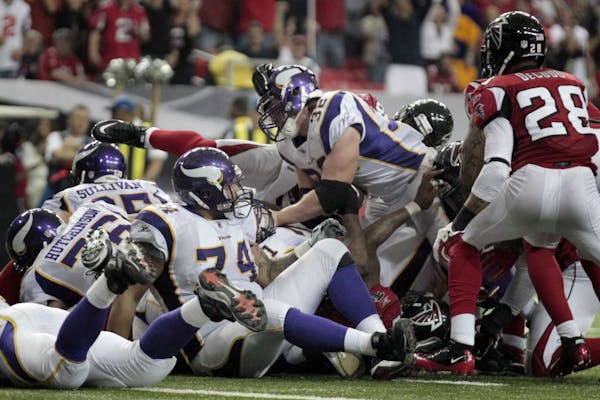Jamarca Sanford thought he was done with this.
The Vikings safety played college football at Mississippi. In his final two years he played against a Florida team led by Tim Tebow, who ran the spread option to near perfection. Once Sanford moved on to the NFL, he had to figure he'd be done defending that scheme.
"Yeah, but Tim Tebow brought it back," Sanford said.
So it's back to the future for the Vikings defense, where a number of players are tapping into their college experiences to prepare to defend Tebow and Denver on Sunday at the Metrodome.
Denver's offense -- a favorite in high schools and colleges around the country -- is rarely used in the NFL. But with Tebow, the Broncos improved to 6-5 -- and 5-1 with him as the starting quarterback -- with an overtime victory at San Diego as Tebow ran the ball 22 times.
The Vikings were referring to Tebow as a fullback with a quarterback's number.
"Tebow, right now, is doing what they need to do to win games," Vikings defensive coordinator Fred Pagac said. "They are controlling the football, and they are not making mistakes. He is a competitive son of a gun."
Said Tebow: "It's been a lot of fun to live out my dream every day."
The zone read isn't complicated to explain, but it's a little tougher to defend, especially run by a guy like Tebow. You'll see him in the shotgun along with one running back, sometimes two as the ball is snapped. Tebow has three options. He can hand the ball off, run it himself or pass. It all depends on what he sees. He reads the defense, seeing what the linemen and linebackers are doing. If they're heading to the hole he would run to, Tebow can hand the ball off. If the defenders are keying on the back, he can keep it himself.
The passing option usually comes after a defense has been lulled to sleep by a string of running plays. Often that pass will come off play-action, with the receiver running a double move -- a stop-and-go, or an out-and-up.
"They'll trick you now and then with a pass play," Sanford said. "So you have to be on your assignments."
The Vikings, it would seem, will have to tweak their Cover 2 scheme to get an extra man closer to the line of scrimmage. Against the option, every player has an assignment and has to stick with it. The ends have to contain, and all the linemen have to monitor their gaps. The linebackers and safeties have to account for all the running backs and for Tebow. Cornerbacks, often in single coverage, have to stick to their man.
There was some talk this week that the Broncos' run-first offense would benefit a Vikings team decimated by injuries in the secondary. Perhaps. But the run defense has to be sound.
"Everybody will have a responsibility for a guy," defensive end Jared Allen said. "And you have to do it. Because the one time someone doesn't do what they're supposed to, that's when it breaks."
Sanford's Mississippi squad lost to Florida in his junior year, but in 2008, when Sanford was a senior, Ole Miss went to Florida and handed the Gators their only loss in a championship season.
In the NFL, the offense has worked at least in part because of its novelty, and Sanford predicted defenses will catch up quickly. Broncos coach John Fox said one problem with running such a unique offense is that there isn't tape available to see how opponents will defend it.
"We really never know until the game starts," Fox said.
Tebow said some opponents have tried to stay with their base defense while others have adjusted, bringing more people into the box, minding their gaps better. "The big key for us is going into games and being able to adjust on the sidelines, make corrections," he said.
But the way games have ended lately has pushed the Broncos back into the playoff mix. Can that success continue?
"Yeah, sure it could," Pagac said. "If Tebow stays healthy and they go from there, yeah. But he's taking a lot of hits, too."
